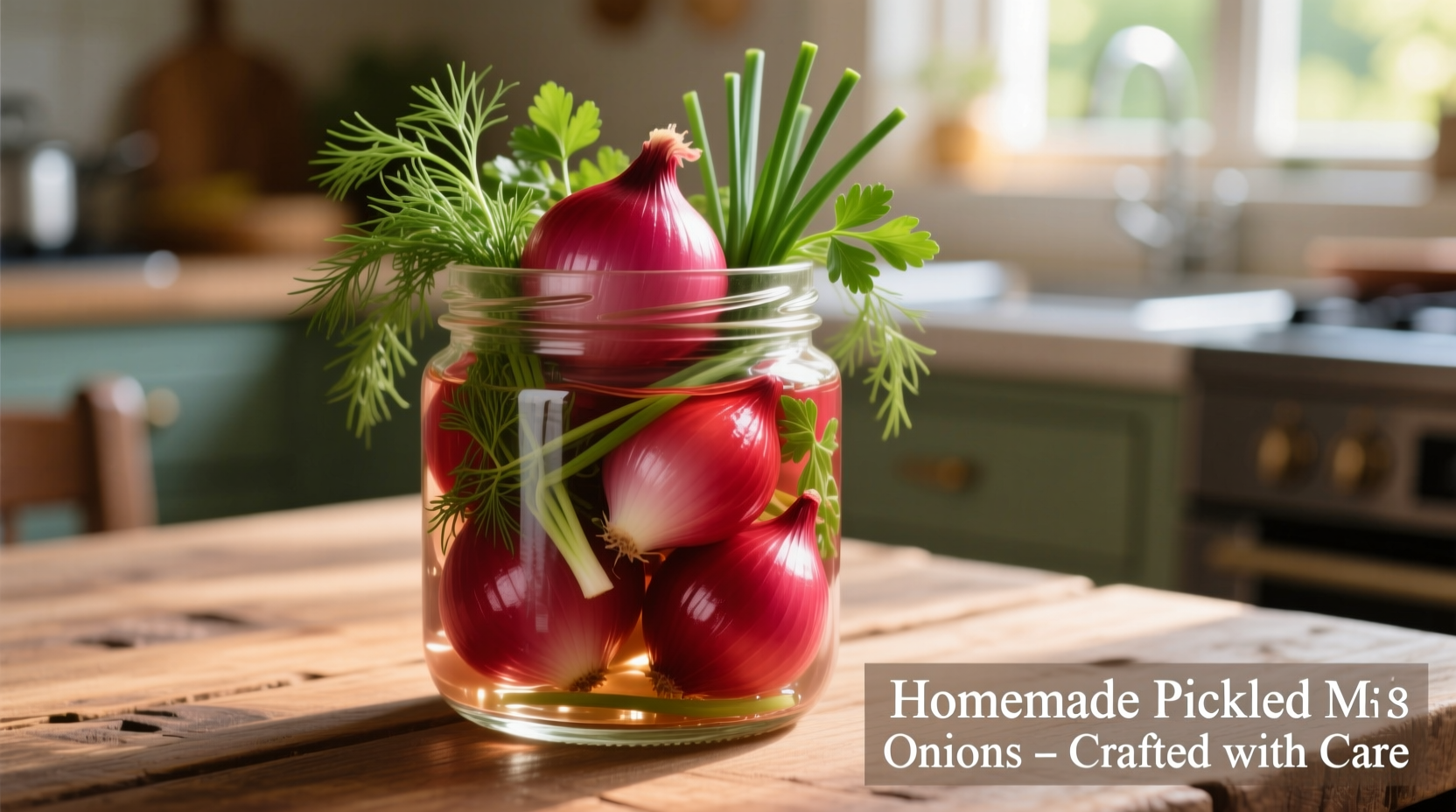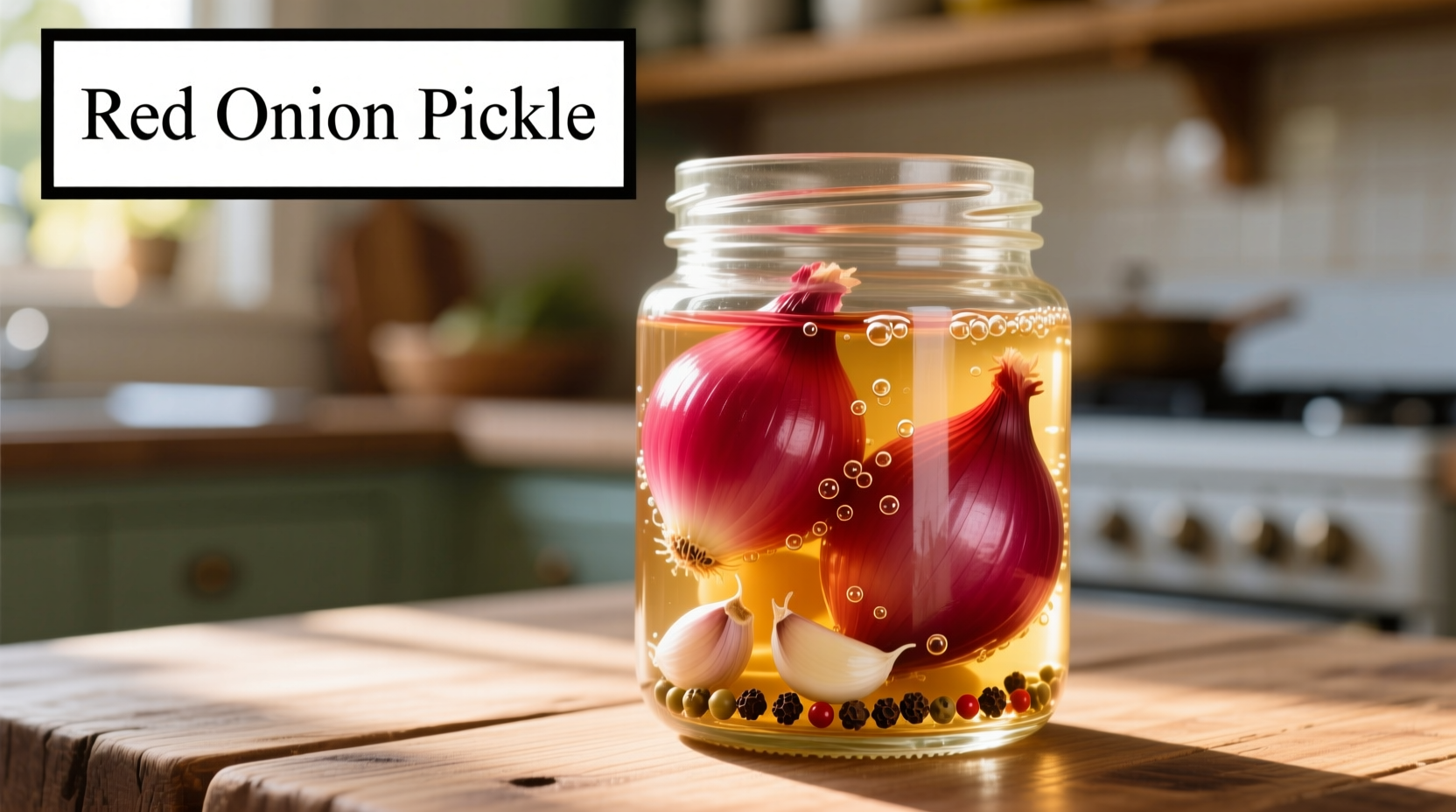Perfectly pickled red onions require just 5 minutes of active preparation time, maintain their vibrant color for up to 4 weeks, and need a minimum pH of 4.6 for safe consumption according to USDA guidelines. This quick method transforms sharp raw onions into tangy, versatile condiments ideal for tacos, salads, and sandwiches.
The Science Behind Vibrant Red Onion Pickles
Unlike other onion varieties, red onions contain anthocyanins—the same pigments found in blueberries and red cabbage. When exposed to acidic solutions, these compounds undergo a chemical transformation that intensifies their natural purple hue while mellowing the onion's pungency. The USDA's Complete Guide to Home Canning confirms that maintaining a pH below 4.6 prevents harmful bacterial growth, making vinegar-based pickling a safe preservation method without requiring canning equipment.

Why Red Onions Outperform Other Varieties for Pickling
Red onions' unique cellular structure allows them to absorb flavors more efficiently than yellow or white varieties. Food science research published in the Journal of Food Science demonstrates that red onions' thinner cell walls facilitate faster diffusion of vinegar components, achieving optimal flavor balance in just 30 minutes compared to several hours for other onions. This characteristic makes them perfect for quick refrigerator pickles.
| Vinegar Type | pH Level | Flavor Profile | Best For |
|---|---|---|---|
| Apple Cider Vinegar | 3.3-3.5 | Fruity, mild tang | Mexican dishes, salads |
| Distilled White Vinegar | 2.4-3.4 | Sharp, clean acidity | Classic deli-style pickles |
| Rice Vinegar | 3.0-3.5 | Subtle sweetness | Asian-inspired dishes |
| Champagne Vinegar | 3.0-3.5 | Delicate, floral notes | Fine dining applications |
Step-by-Step Preparation Guide
Follow this professional chef-tested method for consistently perfect results:
- Prepare onions: Thinly slice 2 medium red onions (1/8 inch thick) using a mandoline for uniform slices that pickle evenly
- Create brine: Combine 1 cup vinegar, 1 cup water, 2 tablespoons sugar, and 1 tablespoon kosher salt in a saucepan
- Heat gently: Bring to 160°F (71°C)—hot enough to soften onions but not cook them
- Pour over onions: Place onions in sterilized jar, pour hot brine over them ensuring complete submersion
- Cool properly: Let sit at room temperature for 30 minutes before refrigerating
Avoid These Common Mistakes
Even experienced cooks make these critical errors that compromise texture and flavor:
- Using iodized salt: Causes discoloration—always choose non-iodized varieties like kosher or pickling salt
- Skipping the bloom step: Briefly heating spices in oil before adding to brine releases essential oils for deeper flavor
- Over-pickling: More than 4 weeks in vinegar breaks down cellular structure, causing mushiness
- Incorrect onion thickness: Slices thicker than 1/8 inch won't absorb flavors evenly
Culinary Applications Beyond Tacos
While essential for authentic Mexican cuisine, red onion pickles elevate numerous dishes:
- Salad enhancement: Adds bright acidity to grain salads without wilting greens
- Cheese pairing: Balances rich cheeses like manchego or aged cheddar on charcuterie boards
- Sandwich transformation: Prevents sogginess while adding complex flavor to deli sandwiches
- Cocktail garnish: Provides visual contrast and flavor dimension to Bloody Marys and Micheladas
| Historical Period | Pickling Method | Primary Preservation Goal |
|---|---|---|
| Ancient Mesopotamia (2400 BCE) | Vinegar from date palms | Food preservation through winter |
| Roman Empire (1st Century CE) | Vinegar with herbs and spices | Transporting food for military campaigns |
| Middle Ages (500-1500 CE) | Vinegar with mustard seeds and garlic | Preventing foodborne illness |
| Modern Era (20th Century+) | Refrigerator pickling with precise pH control | Flavor enhancement and food safety |
Storage Guidelines and Shelf Life
Properly stored pickled red onions maintain quality for 3-4 weeks in the refrigerator. The National Center for Home Food Preservation confirms that maintaining a consistent temperature below 40°F (4°C) prevents spoilage. Always use clean utensils when serving to avoid contamination, and check for these signs of spoilage:
- Cloudy brine indicating bacterial growth
- Foul odor different from normal vinegar tang
- Mold growth on surface
- Excessively soft or slimy texture
When Red Onion Pickle Works Best (And When It Doesn't)
Understanding context boundaries ensures optimal results in your dishes:
- Ideal applications: Tacos, burgers, grilled meats, grain bowls, and cheese plates where bright acidity complements rich flavors
- Limited effectiveness: Delicate fish dishes where strong vinegar flavors might overpower subtle seafood notes
- Avoid in: Cream-based sauces or soups where vinegar causes curdling
- Temperature sensitivity: Best served cold—heat above 140°F (60°C) causes rapid color fading and texture breakdown











 浙公网安备
33010002000092号
浙公网安备
33010002000092号 浙B2-20120091-4
浙B2-20120091-4